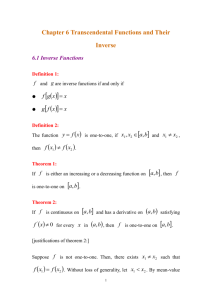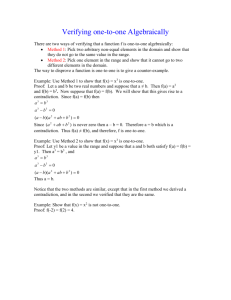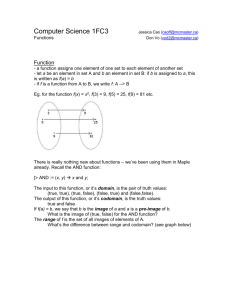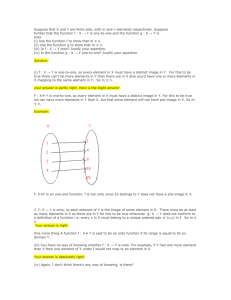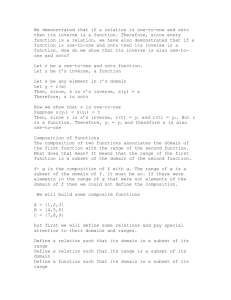Inverse functions.
advertisement
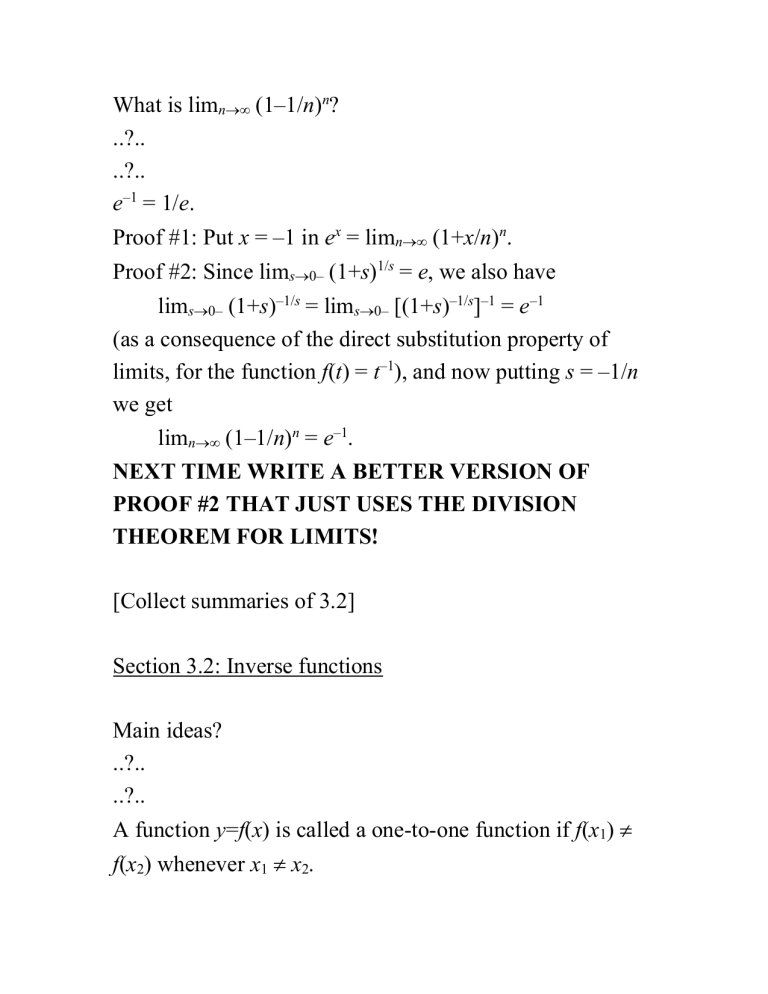
What is limn (1–1/n)n? ..?.. ..?.. e–1 = 1/e. Proof #1: Put x = –1 in ex = limn (1+x/n)n. Proof #2: Since lims0– (1+s)1/s = e, we also have lims0– (1+s)–1/s = lims0– [(1+s)–1/s]–1 = e–1 (as a consequence of the direct substitution property of limits, for the function f(t) = t–1), and now putting s = –1/n we get limn (1–1/n)n = e–1. NEXT TIME WRITE A BETTER VERSION OF PROOF #2 THAT JUST USES THE DIVISION THEOREM FOR LIMITS! [Collect summaries of 3.2] Section 3.2: Inverse functions Main ideas? ..?.. ..?.. A function y=f(x) is called a one-to-one function if f(x1) f(x2) whenever x1 x2. More precisely, a function y = f(x) with domain A and range B is one-to-one iff for all x1, x2 in A with x1 x2, we have f(x1) f(x2). Examples and non-examples: The function y = x3 from R to R ... ..?.. ..?.. is one-to-one. The function y = x2 from R to R ... ..?.. ..?.. is not one-to-one, because (for instance) 32 = (–3)2 even though 3 –3. The function y = x2 from [0,) to [0, ) ... ..?.. ..?.. is one-to-one. The function y = x2 from (–,0] to [0, ) ... ..?.. ..?.. is one-to-one. Horizontal Line Test: A function is one-to-one if and only if no horizontal line intersects its graph more than once. Let f be a one-to-one function with domain A and range B. Then its inverse function (denoted f –1) is the function with domain B and range A satisfying f –1 (y) = x f(x) = y Examples: The inverse of the function f(x) = x3 from R to R is ... ..?.. ..?.. the function f –1(x) = x1/3. The inverse of the function f(x) = x2 from R to R ... ..?.. ..?.. does not exist, since f is not one-to-one on R! The inverse of the function f(x) = x2 from [0,) to [0,) is ... ..?.. ..?.. the function f –1(x) = x1/2. The inverse of the function f(x) = x2 from (–,0] to [0,) is ... ..?.. ..?.. the function f –1(x) = –x1/2. If you have the graph of the one-to-one function f, you can obtain the graph of the function f –1 by flipping the graph of f over the line y = x. Another word for a one-to-one function is an invertible function. If f is an invertible function with domain A and range B, then for all a in A, f –1(f(a)) = ..?.. ..?.. a, and for all b in B, ..?.. ..?.. f(f –1(b)) = b. (Example: For all x in [0,), sqrt(x2) = x and (sqrt(x))2 = x.) Another way to think about inverse functions: to compute values of f –1, use the graph of y=f(x), but switch the roles played by the two axes: To compute f –1(b), find the point b on the y-axis, draw the horizontal line y=b, and find its unique point P of intersection with the curve y=f(x); the xcoordinate of P is the unique value a satisfying f(a)=b. [Draw the example y=x3.] Fact: If f is an increasing function then f is one-to-one. (Note: Here “increasing” means “strictly increasing”.) Proof: If x1, x2 are in the domain of f with x1 < x2, then since f is increasing, f(x1) < f(x2), so that f(x1) ≠ f(x2). Likewise, every decreasing function is one-to-one. Is every one-to-one function on an interval I either increasing or decreasing? ... ..?.. ..?.. No; e.g., look at the function f with f(x) = 1/x for x other than 0 and f(0) = 0, on the interval [–1,1]. Can we rescue the idea of a converse somehow? More specifically, can we make the converse true by adding an extra hypothesis? … ..?.. ..?.. Theorem: If f is a continuous function whose domain is some interval I, and f is one-to-one, then f is either increasing on all of I or decreasing on all of I. In either case, the inverse function f –1 is also continuous. (We’ll prove this later using the Mean Value Theorem.) What about differentiability? ..?.. ..?.. Theorem 7: Let f be a one-to-one differentiable function, and let a=f –1(b) for some number b in the range of f. If f (a) 0, f –1 is differentiable at b, and (f –1)(b) = 1 / f (a). Example: Let f(x) = x3, b = 8, and a = f –1(8) = 2. f (2) = 3(2)2 = 12 0, so (f –1)(8) = 1/12. Check: f –1(x) = x1/3, so (f –1) (x) = (1/3)x–2/3 and (f –1) (8) = (1/3)8–2/3 = (1/3)(1/4) = 1/12. Keep in mind that f –1 and 1/f denote very different functions! E.g., if f(x) = x3, then (1/f)(x) = x–3, but f –1(x) = x1/3.) Intuition for Theorem 7: When we flip the graph of the function over the line y = x, we flip the tangent line of y = f(x) at (a, b) over the line y = x to become the tangent line of y = f –1(x) at (b, a), so we take the reciprocal of its slope (since the rise becomes the run and vice versa). More intuition: We have b = f(a), a = f –1(b). Picture a secant line for the function f, joining (a, b) to some nearby point (a+a, b+b), with slope b/a. This corresponds to a secant line for the function f –1, joining (b,a) to (b+b, a+a), with slope a/b. As a and b approach 0, the reciprocal relationship between the slopes always holds, so it holds in the limit, and the slope of the tangent to f –1 at (a, b) is the reciprocal of the slope of the tangent to f at (b, a). Proof of Theorem 7: See Stewart, p. 156. Check that the theorem is consistent with what we know: For convenience, write g = f –1. We have f(g(x)) = x, so by the chain rule, f (g(x)) g(x) = 1, whence g(x) = 1/f (g(x)). In particular, putting x = b and g(x) = a, we have g(b) = 1/f (a). Why isn’t the preceding check a proof of Theorem 7? ... Think about this for next time!
